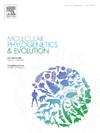系统基因组学对象鼻虫科(螳螂亚目:螳螂科)前叶模仿进化的研究。
IF 3.6
1区 生物学
Q2 BIOCHEMISTRY & MOLECULAR BIOLOGY
引用次数: 0
摘要
关于兽尾亚科的进化关系仍然存在争议,特别是关于叶状前庭的形态多样性和分类,这是一种宽而扁平的胸廓结构。传统上被认为是Rhombodera属的一个决定性特征,特别是作为一个特殊的前额特征,线粒体系统基因组学对这一假设提出了质疑,认为可能存在同源性。在这项研究中,我们生成了30个高质量的Hierodulinae转录组,并建立了第一个mantodea特异性同源数据库(Mantodea_odb),以确定通用单拷贝同源物(USCOs)用于系统基因组推断。通过整合基因组和转录组学数据,我们利用最大似然和聚结的方法重建了得到良好支持的系统发育树,为评估形态特征的进化模式提供了框架。分化时间估算和祖先状态重建表明,叶状前体在Hierodulinae中多次独立演化,时间上对应于古近纪晚期至新近纪早期(渐新世-中新世过渡,约20-23 Ma)。值得注意的是,我们的分子系统发育表现出与男性生殖器形态所描绘的不同分支的强烈相关性,从而解决了长期存在的分类不一致。这些发现揭示了象形虫科同质性前额特征和保守性生殖器形态之间的分离进化模式,展示了系统基因组学如何区分趋同性和保守性特征。本文章由计算机程序翻译,如有差异,请以英文原文为准。

Phylogenomics insights into the evolution of pronotal leaf mimicry in Hierodulinae (Mantodea: Mantidae)
The evolutionary relationships within the mantid subfamily Hierodulinae remain contentious, particularly concerning the morphological diversity and classification of species with leaf-like pronotum, which are broad and flattened thoracic structures. Traditionally regarded as a defining characteristic of the genus Rhombodera, specifically as a specialized pronotal trait, mitochondrial phylogenomics has cast doubt on this assumption, suggesting potential homoplasy. In this study, we generated 30 high-quality transcriptomes of Hierodulinae and established the first Mantodea-specific orthologous database (Mantodea_odb) to identify universal single-copy orthologues (USCOs) for phylogenomic inference. By integrating genomic and transcriptomic data, we reconstructed well-supported phylogenetic trees using both maximum likelihood and coalescent-based approaches, which provided the framework to assess evolutionary patterns of morphological traits. Divergence time estimation and ancestral state reconstruction suggested that the leaf-like pronotum evolved independently on multiple occasions within Hierodulinae, corresponding temporally to the late Paleogene to early Neogene (Oligocene-Miocene transition, ca. 20–23 Ma). Notably, our molecular phylogeny exhibits a strong correlation with distinct clades delineated by male genital morphology, thereby resolving longstanding taxonomic inconsistencies. These findings reveal decoupled evolutionary patterns between homoplastic pronotal traits and conserved genital morphology in Hierodulinae, showcasing how phylogenomics can discriminate between convergent and conserved traits.
求助全文
通过发布文献求助,成功后即可免费获取论文全文。
去求助
来源期刊
CiteScore
7.50
自引率
7.30%
发文量
249
审稿时长
7.5 months
期刊介绍:
Molecular Phylogenetics and Evolution is dedicated to bringing Darwin''s dream within grasp - to "have fairly true genealogical trees of each great kingdom of Nature." The journal provides a forum for molecular studies that advance our understanding of phylogeny and evolution, further the development of phylogenetically more accurate taxonomic classifications, and ultimately bring a unified classification for all the ramifying lines of life. Phylogeographic studies will be considered for publication if they offer EXCEPTIONAL theoretical or empirical advances.

 求助内容:
求助内容: 应助结果提醒方式:
应助结果提醒方式:


